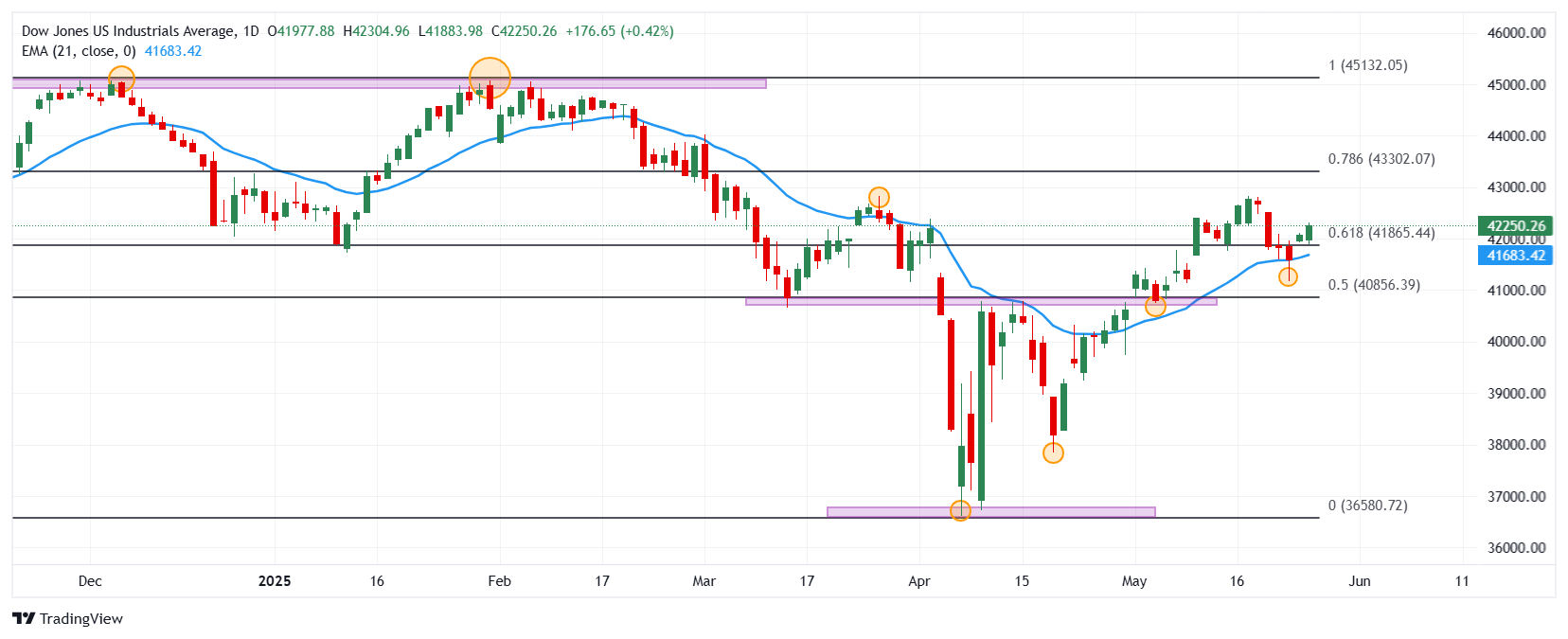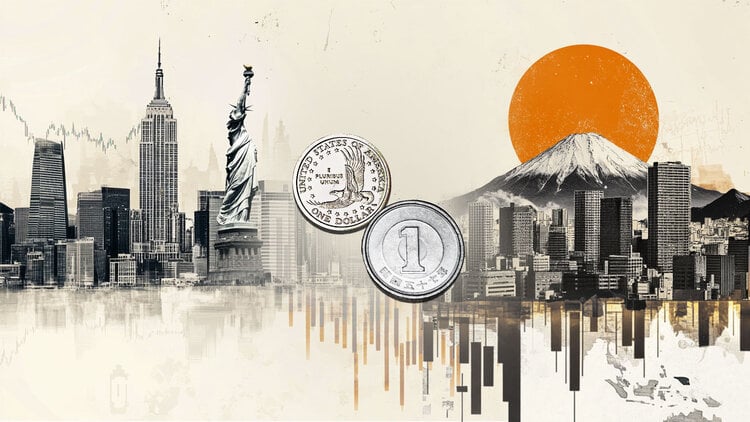- The Dow Jones rebounds 0.50% daily, reaching maximum of May 21 in 42,207.
- Nasdaq 100 wins 0.75% in the day, led by Marvel Technology (MRVL).
- The S&P 500 rises 0.63% on Tuesday, supported by Teradyne (TER).
- The requests for durable goods in the United States decrease 6.3% in April, improving market expectations.
- The Conference Board Conference Conference Index rises to 98.0 points in May, above the projections of analysts.
The Dow Jones marked a minimum of the day in 41883, finding aggressive buyers who took the index to May 21 in 42,257.
The Dow Jones industrial average opened in 41,977, while the Nasdaq 100 technological index began operating at 21,199. The S&P 500 began negotiations in 5,865, signing its second consecutive day up.
Nike and Nvidia Corporation lead the profits in Dow Jones
The Dow Jones index advances 0.50% in the day, operating at the time of writing at 42,265.
Nike titles (NKE) have a gain of 3.95% on the second day of the week, reaching May 20 at 62.55 $.
In the same tune, the shares of Nvidia (NVDA) regret 3.14% daily, reaching maximum of May 21 at $ 135.66.
In this sense, the Dow Jones uploads 175 points, reaching maximums of May 21 in 42,304, spinning two consecutive upward sessions.
The Nasdaq 100 remains on positive terrain driven by Marvel Technology and Tesla
The Nasdaq 100 technological index wins 0.75% in the day, currently quoting at 21,400.
The values of Marvell Technology (MRVL) are appreciated 7.68% daily, visiting May 15 at $ 65.52, leading profits in the stock market index.
On the other hand, the shares of Tesla (TSLA) shoot at 6.84% today, reaching maximums not seen since February 19 in 363.00.
In this context, the Nasdaq 100 goes up 161 points, reaching maximums of May 21 in 21409.
The S&P 500 lifes up after positive economic data from the United States
Based on information published by the US Census Office, the requests for lasting goods decreased by 6.3% in April. This figure has an improvement compared to the planned contraction of 7.9% of analysts.
Similarly, the Conference Board Conference Conference Index increased to 98.0 points in May, exceeding 86.0 points observed in April.
The S&P 500 records an advance of 0.63% in the day, reaching maximum of May 21 in 5,915, signing two consecutive upward sessions. Teradyne’s shares (TER) is triggered by 5.90% on Tuesday, visiting May 16 at 82.39.
Technical Analysis of Dow Jones
The Dow Jones reacted upwards from a short -term support given by the minimum of May 23 in 41,175. The next closest support is observed in 40,747, minimum of May 6 in convergence with the 50% fibonacci setback. To the north, the key resistance is located at 45,068, a pivot point of January 31.
Dow Jones daily graphics

Dow Jones Faqs
The Dow Jones Industrial Avenge, one of the oldest stock market indexes in the world, consists of the 30 most negotiated values in the United States. The index is weighted by the price instead of capitalization. It is calculated by adding the prices of the values that compose it and dividing them by a factor, currently 0.152. The index was founded by Charles Dow, also founder of the Wall Street Journal. In recent years it has been criticized for not being sufficiently representative, since it only follows 30 companies, unlike broader rates such as S&P 500.
There are many factors that promote the Dow Jones Industrial Average (DJIA) index. The main one is the added performance of the companies that compose it, revealed in the quarterly reports of business benefits. The American and world macroeconomic data also contribute, since they influence investor confidence. The level of interest rates, set by the Federal Reserve (FED), also influences the DJia, since it affects the cost of credit, on which many companies depend largely. Therefore, inflation can be a determining factor, as well as other parameters that influence the decisions of the Federal Reserve.
Dow’s theory is a method to identify the main trend of the stock market developed by Charles Dow. A key step is to compare the direction of the Dow Jones Industrial Avenge (DJIA) and the Dow Jones Transportation Average (DJTA) and just follow the trends in which both move in the same direction. The volume is a confirmation criterion. The theory uses elements of maximum and minimum analysis. Dow’s theory raises three phases of the trend: accumulation, when intelligent money begins to buy or sell; Public participation, when the general public joins the trend; and distribution, when intelligent money abandons the trend.
There are several ways to operate with the DJ. One of them is to use ETF that allow investors to negotiate the DJ as a single value, instead of having to buy shares of the 30 companies that compose it. An outstanding example is the SPDR Dow Jones Industrial Avenge ETF (day). Future contracts on the DJ allow the specular operators about the future value of the index and the options provide the right, but not the obligation, to buy or sell the index at a predetermined price in the future. Investment funds allow investors to buy a part of a diversified portfolio of DJ values, which provides exposure to global index.
Source: Fx Street
I am Joshua Winder, a senior-level journalist and editor at World Stock Market. I specialize in covering news related to the stock market and economic trends. With more than 8 years of experience in this field, I have become an expert in financial reporting.





